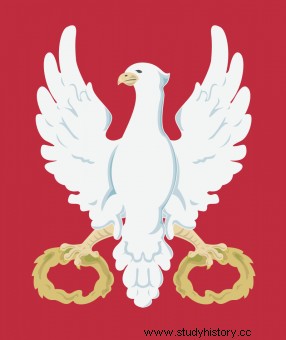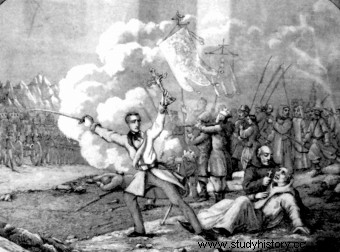It was supposed to be an uprising unlike any other. A riot in which peasants fight hand in hand with the nobility for the country's independence. The insurrection turned into a tragedy, and the people themselves turned out to be the liquidator of the rebellion.
The history of the two national uprisings clearly showed that victory was possible only with the numerous support of the peasantry. Kosciuszko, who was an ardent supporter of social reforms, understood this perfectly. The experiences from the Kościuszko and November Uprising were not encouraging. The nobility (or at least its dominant part) would sooner agree to the fall of the country than even minor changes improving the welfare of the peasants. The Seym did not agree to such concessions when in 1831 Russian troops marched on Warsaw.
After the defeat of the November Uprising, the conspiratorial movement moved to Galicia, where the greatest freedom reigned. There was still another national outburst in mind. Therefore, the most was happening in the Republic of Krakow. In 1835, the Association of the Polish People was established there, proclaiming reform slogans. Its activist was Edward Dembowski - the later organizer of the Krakow Uprising, only 24 when it broke out.
Activists such as Dembowski combined the postulates of independence with the social ones. They requested the abolition of former feudal relations, the abolition of serfdom, the enfranchisement of the peasants and the introduction of democratic rule.
Not with the nobility. Against the masters - yes!
The conspirators showed an exceptional lack of realism. The chances of acquiring the peasant population under the then conditions were practically zero. The involvement of the nobility was also moderate. In the village of Galicia, the feeling of injustice, anger towards the nobility and the desire for revenge for physical and economic violence, enslavement and humiliation grew. For the peasant, the enemy was the "lord", and the protector was the emperor and his administration. Indeed, the Austrians put an end to violence and exploitation, but they did not go very far in these reforms.
Nevertheless, in the eyes of the peasants, they became their defenders. They skillfully played this card against the Polish nobility. The expectation that under these conditions the peasants would turn their weapons against the "benefactors" alongside the hated nobility was highly wishful.
Read also:Did Polish national uprisings make any sense?
In the first days of the uprising, in February 1846, small units began to fight to attack the weaker Austrian posts. The insurgent forces were rather weak, so the Austrians did not have to be particularly involved in suppressing the insurrection.

Eagle from the time of the Krakow Uprising
The more so because the peasants took the matter into their own hands, terrified by the news spread by the Austrians about the uprising prepared by the nobility, and massively moved to prevent this "misfortune". The peasants attacked small units and returned the captured insurgents to the partitioning powers.
At the same time, mainly in Western Galicia, peasants led by Jakub Szela began raiding noble courts . They murdered about 1,000 people in often cruel ways . These events were called "the robbery" or the "Galician slaughter".
Austrians save the insurgents
The center of events was Krakow, where about 6,000 insurgents were mobilized (of which only 2,000 had weapons). At that time, Krakow had the status of a Free City - the Republic of Krakow. On February 22, the National Government was formed there and announced the Manifesto to the Polish Nation.
The greatest tragedy of the uprising were the events - it is difficult to even call them a battle - in Gdów. First, however, the insurgents managed to capture Wieliczka and strengthen the forces in this area to 380 fighters, armed with, among others in lances and scythes mounted upright. On February 26, they reached Gdów. An Austrian unit of 500 foot and 170 cavalry was located near the village. Shots fired at Polish guards caused them to escape.

Dembowski tried to speak to the peasants while walking with the cross in the procession, but he was killed by an Austrian bullet.
In Gdów, the rest of the confused insurgents ran to meet the Austrians. Panic ensued and a disorderly retreat began. The peasants, pinned to the cemetery wall and throwing weapons, were caught up with the insurgents. They murdered them ruthlessly . 154 fighters died and 59 were taken prisoner.
The survivors owe their rescue to Austrian officers. On the enemy's side, no one was injured. The Austrians took Krakow without any problems. Before this happened, Dembowski tried to speak to the peasants while walking with the cross in the procession, but he was killed by an Austrian bullet.
Read also:Galician plunder. The causes and course of the slaughter of landowners in February 1846
Two years too soon
The uprising did not break out in other partitions, despite the attempts made. Eastern Galicia was not included either. In Lviv, he was opposed by Franciszek Smolka, who was already becoming a leader of patriotic movements in Galicia. He considered that an insurgency would harm the national interest. There were also no events described as "the Galician slaughter" in these lands.
Krakow lost its status as a Free City, but its incorporation into the Austrian state accelerated the city's development. The Austrians pacified the peasant revolt, and in 1848 they abolished serfdom. The uprising also turned out to be a false start:two years later, the Spring of Nations broke out.
Bibliography:
- Adam Leszczyński:"People's History of Poland", Warsaw, 2020.
- Bolesław Limanowski:"History of the Revolutionary Movement in Poland in 1846", from www.rcin.org.pl.
